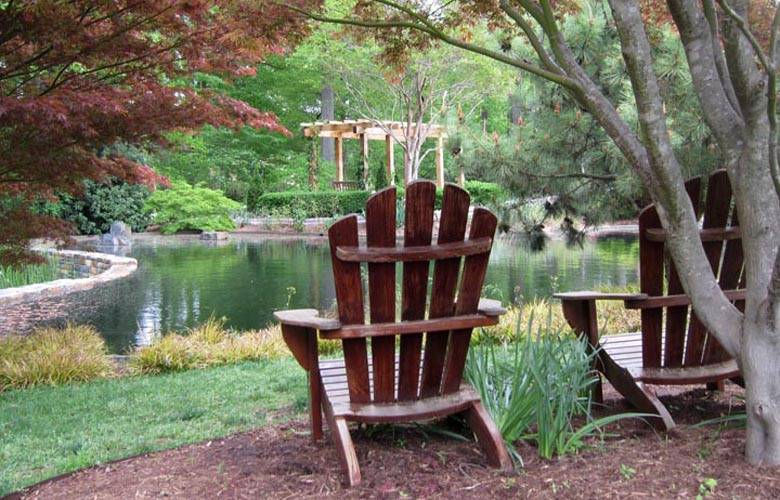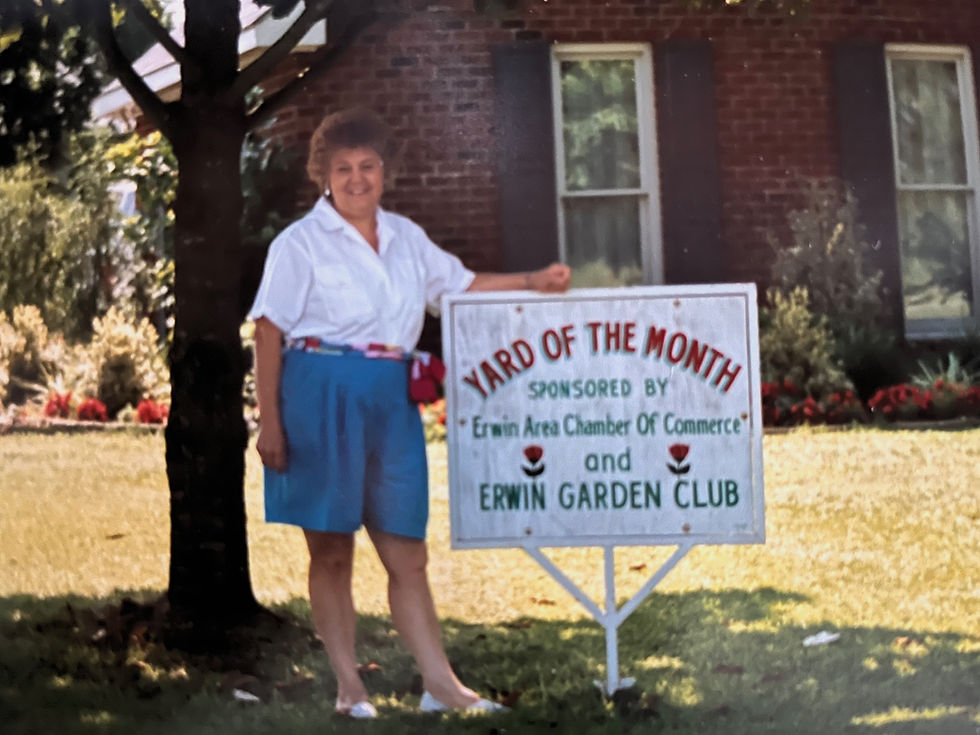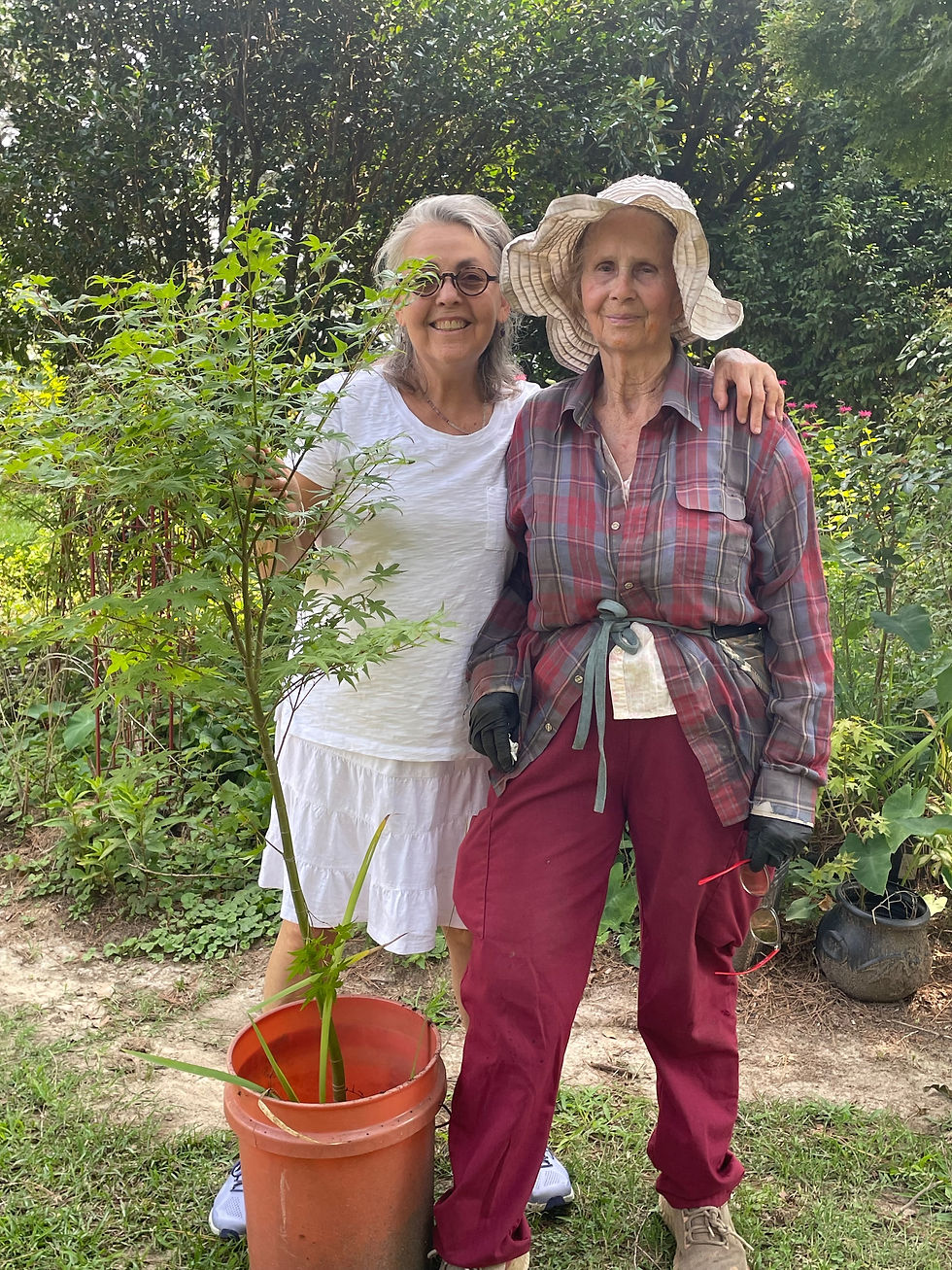
Are you the caretaker of an object that tells your family's story? If so, take time to indite the relic's history and sentiment so future family members don't have to wonder: "What is this thing? Why did she hang on to it?" In our case, a graceful maple tree with delicate five-pointed lime green leaves is the griot. Here's the story of our tree.

For our 45th wedding anniversary I gave my husband Charles the great granddaughter of the tree we planted around 1981 in front of our first home in Durham, North Carolina. I planted the seedling in the back garden of our new home in Beaufort in late June, 2023.
On July 1, our anniversary, I led Charles to the garden and presented my gift. The look he gave me was all I needed to confirm that my gift was perfect and priceless. The tree traced our life full circle around the globe and back home to North Carolina. It reminds us of where our married life began and that, like the tree, we still grow in love.

My appreciation for the tree comes from a maternal family of gardening zealots from whom I inherited a passion for plants. When I was a small child we went to the "country" to visit my great grandmother, Sarah Penelope Byrd Norris. When we arrived, she tied on her cotton bonnet and marched us around the garden to see her "snowball bushes" and climbing roses, at times providing a cutting.
My mother and her relatives rooted the most beautiful plants in their gardens and gave them as gifts, as if to say, "I am going to give you a piece of something that is dear to me." In that way, plants in our gardens speak to us as ancestors from their graves.
The origin of this spunky little tree goes back at least two generations to an Acer palmatum in the Culberson Asiatic Arboretum of Sara P. Duke Gardens in Durham. The oldest known fossils of Acer are from the late Paleocene of Northeast Asia and northern North America, around 60 million years old.
There are over 250 cultivars of Japanese Maples. Acer palmatum forms have been a part of their native Japanese history for centuries; it is believed the first recorded plant dates to the seventh century. The name, Acer palmatum (means hand) was is attributed to a Swiss botanist. In Asia it is called Momji, hand of a baby. Japanese maples have five to seven-lobed leaves.
[photo: visit-duke-gardens-OS-041913 090-ODAD]

The Sara P. Duke Gardens in Durham has several varieties nestled along bridges, streams and ponds in its Asian Arboretum that was designed by Ellen Biddle Shipman in the 1930's.
In the 1950's, Rose Spearman, a South Carolina transplant to Durham and avid gardener, frequented the gardens. She admired a maple tree planted in the 1930's, that was most likely a gift from another arboretum. Rose developed friendly relations with the gardeners and begged for a seedling that sprouted at the base of the tree. The gardeners obliged and told her it was a Chinese maple, a unique variety of a Japanese maple cultivated in China.
The Chinese maple, native to southeast and south-central China can grow 15 to 30 feet tall, its leaves turning red in fall. The five-lobed (Acer pentaphyllum) is considered endangered. It grows in climates 7 to 9. Japanese maples can grow in deep shade, but the Chinese maple requires gentle shade with some morning sunlight of three to four hours for glorious growth. Intense sun stunts its growth. Its natural form is a high and upright shape with picturesque limb formations, poised like a dancer’s. Bark is grey green and rough in appearance.
I was pregnant with daughter Bronwyn when we bought our first home at 2203 Sprunt Avenue, Durham, NC, in 1980. The cape cod style house, built in 1945, was perched on a hill and included several large oaks and sycamores on the property. A bonus to our property was the neighbor’s stunning garden landscaped with trees and flowering shrubs that shaded our screened porch on the left side of the house and a hidden boxwood and rose garden we could see from our back terrace. That garden belonged to tall and stately Rose Spearman, who had a crown of white hair and a colorful personality. Easy to see how she talked the Duke gardeners out of the tree.
On many occasions Rose saved my life rocking my colicky baby, serving me wine spritzers on a mossy green brick courtyard shaded by the thirty-year-old stunning maple tree from the Duke Gardens. She served tea parties under the tree for toddler Bronwyn, using an antique toy teapot. Before tea time, she led Bronwyn upstairs to her attic, past shelves of arcana laid out like a museum, commenting on this and that, as they retrieved Miss Annie Bynum's big red hat to wear for the tea party under the maple tree.
Rose told me that as a child she liked to rock on her front porch in Sumter, South Carolina and watch for a retired school teacher who walked by on her weekly errands. Rose said, “As a spunky nine-year-old I called out to her. Ms. Annie Bynum when you die I want you to ‘will’ me that hat." And she did.
Rose intended to pass it on to Bronwyn but Rose died while we were living in Peru. Her only son came down from Philadelphia, took some of the exquisite pieces of South Carolina furniture, and gave the contents of her attic to a Goodwill store.
The Chinese Maple tree is the canopy for those memories. Bronwyn didn’t inherit the hat but she will never forget those tea parties wearing the hat under the tree and the spell of Ms. Rose. She can watch our newly planted tree grow year by year and remember.

Rose gave us one of the seedlings that grew from the base of her tree and we planted it near our front door just before Charles joined USAID in 1984 and we moved abroad. Headed home each summer, we anticipated the growth of the tree that sprouted graceful new branches for us to admire. During the academic year we rented our house to professors on sabbatical, who generally took excellent care of our property. An exception being one over-eager gardener who decided that the lower branches of the tree needed to be removed. The tree and our spirits were wounded, but over the years, it recovered and grew to be one of the most beautiful features of our house.

My mother just had to have one of our tree's seedlings. She was aiming to achieve Erwin's Garden of the Month award and believed the tree would set off one of her garden spaces. Charles reminded her that summers, when we were on home leave and could dig up a seedling, was a bad time to transplant a tree. Stubborn, she told him to bring it anyway and she watered that tree every day of summer and into the fall until it was established. The tree grew beautifully and, yes, she was awarded garden of the month.
Over time this tree sprouted seedlings that mom potted and shared with special people like her sister Rita and her cousin Joyce Lucas, who lives on the outskirts of Dunn, NC. Mom insisted that Charles plant one of the seedlings in front of my aunt's house in Durham so house-bound Aunt Rita could see it from her recliner in the living room. Each summer, Aunt Rita called and told us we had to come and see the tree that Charles planted. The trees given to Aunt Rita and Joyce Lucas were the grand-daughters of our tree.

My mom also took one of the seedlings in a wooden planter when she moved into an apartment for seniors. From her front porch, she watched it grow and stood guard when the pruners came to landscape, threatening them if they thought it should be clipped because other neighbors complained it blocked their views of who was coming and going- a pastime of the elderly.


In 2002 we purchased an historic home in Beaufort and my mom suggested that we plant one of the seedlings. Summer after summer, she’d give me new sprouts and I tried but the places I planted them were exposed to salty wind from the sea or too much sun for it to survive. Recently I went through a box of keepsakes and found this little envelope with a hand-written note - maple tree seeds for Deborah. My heart lurched.

This summer, late June, I went to Dunn, NC to visit my mom in a nursing facility and stayed with my Uncle Lyn and his wife Debbie. Mom at 93 has advanced dementia. She holds important stories and backdrops of our family’s life story that can no longer be unlocked. My uncle Lyn, her young brother, fifteen years her junior, fills in the gaps best he can when I visit. He’s a quiet introspective man but loves to tell stories of bygone days.

Uncle Lyn has a showroom perfect Model A and he suggested that we go for a ride to eat lunch- chili dogs and ice cream-and from there to visit cousin Joyce Lucas's garden. I should add that Uncle Lyn is also plant crazy. The day was glorious. I practiced my Queen Elizabeth wave to the gawking paparazzi along the street who stopped to admire the car, not me, but oh well. The lunch was a once-a-summer indulgence of unhealthy but delicious treats.

[Photo:Joyce and my Mom, Ruth Bowen]
The visit with Joyce brought back swells of memory to the many summers my mom took me to see what cousin Joyce has blooming. These are some of my happiest memories of time spent with my mom.

Uncle Lyn, Aunt Deb, and I pulled up to the front door and found Carlos, Joyce's husband, who was chasing a broken water pipe.


We petted the puppies and then went to look for Joyce who without a doubt would be found under a tree or bush, pruning flowers, or digging up mole tunnels "that are trying to take everything I got." Also, without doubt her gardening hat would have grown an extra safety pin holding it together, and she’d be reaching for clippers from her homemade cotton gardening tools belt.


Her patch of hundreds of iris and gladiolas in the entrance lot had given way to a field of sunflowers edged in flowering shrubs. The dirt drive spreads like a sandy beach under old trees up to her front porch. Everything else on her expansive plot of land is green, green, green or in gorgeous blooms. You will find her 35 mm camera in the mailbox, a quick grab, to photograph a flower.



Joyce Lucas is OBSESSED with her garden. She is out the door in early light and stays there until dusk. A self-trained horticulturist, she talks about each plant at length. She tells me, “I have a sickness. If I see a plant that I don’t have, I can’t stand it until I get it.”
Over the years Joyce dug from roadside ditches, along river banks, in dense forests and from the gardens of relatives and friends. These days you can get some of these plants in nurseries but not back when Joyce was plant hunting. Over the years she shared good company with my mom and Aunt Rita, partners in crime, sleuthing for plants. These days her adoring husband Carlos helps her to prune and transplant prize specimens and tame the grassy paths and fields that set off her landscape.
Lyn, Debbie and I followed Joyce around, listened and gazed. When I visit, I occasionally video her talking, charmed by her delightful regional accent, her enthusiasm and her knowledge. As we walked, she told us the names of plants, often including the southern colloquial and botanical names, and in most cases where she got the plant. She said something that struck me, and touched me. “Half the things in this yard have Ida Ruth (my mom) or Rita’s name (my aunt) on them.”
Meandering down the sloping garden we rounded a curve of hollyhocks, past a patch of Artemisia and behind that came upon a glorious Chinese maple about thirty feed tall. It struck me like an arrow to the heart. I knew it was one of my mother’s babies. I asked Joyce did she get it from my mom, and she said she couldn’t remember, but the size, age and rarity pointed to that period when my mom was digging up the maple tree seedlings, putting them in pots and sharing like gold barter.

Near that elderly maple, in an old rotting fishing skiff, sprouted a baby maple tree. It had been a straight shot for a maple tree seedling to have landing there in spring about three or four years ago.
I said, “I need that tree.”
She said I could have anything I want. She always says that when I note a plant I like but it is easier for her to say than do, not easy to give up her babies.
In this case she did mean that I could have the tree if we could dismantle its tangled roots from the rotting boat and soil beneath. We each gave it a tug and declared we would need a shovel, maybe an ax. But CAN DO Aunt Debbie said., “I can get it,” and after pulling from every angle it finally gave. Perhaps it recognized a compatriot force of nature.

We put the tree in an old paint bucket, nestled it between my legs in the backseat of the model A and drove back to my Uncle Lyn and Aunt Debbie’s house. No longer interested in the roadside admirers, I kept my eyes on the tree.

I was thinking: It has been just the kind of day my mother would have loved. Acquiring something so precious that will not only bring beauty to my garden but also remind me of the loving hands that have given from their garden to mine. Just as, perhaps one day I will give a seedling to daughter Bronwyn and she will remember Ms. Rose and the hat, and one to son Chas who will remember his anticipation each summer of seeing the beautiful Maple tree in front of our Durham house and knowing he was home.

Written by Deborah Llewellyn, 9 August 2023
https://Deborah-Llewellyn.com/blog
Credits:
Flower and tree photos from Joyce's garden taken by Joyce Lucas and Debbie Denton.
Duke Garden photo from Sara P Duke Gardens Website
Anniversary photos taken by Kent Brondel, who happens to be in the right place at the right time, most of the time.
Other photos taken by author.
Thanks to friend Sally Brett for first read and insights into my writing and my life.














Another wonderful story Deborah. I’m looking forward to seeing this tree. It could become the showpiece of your garden.